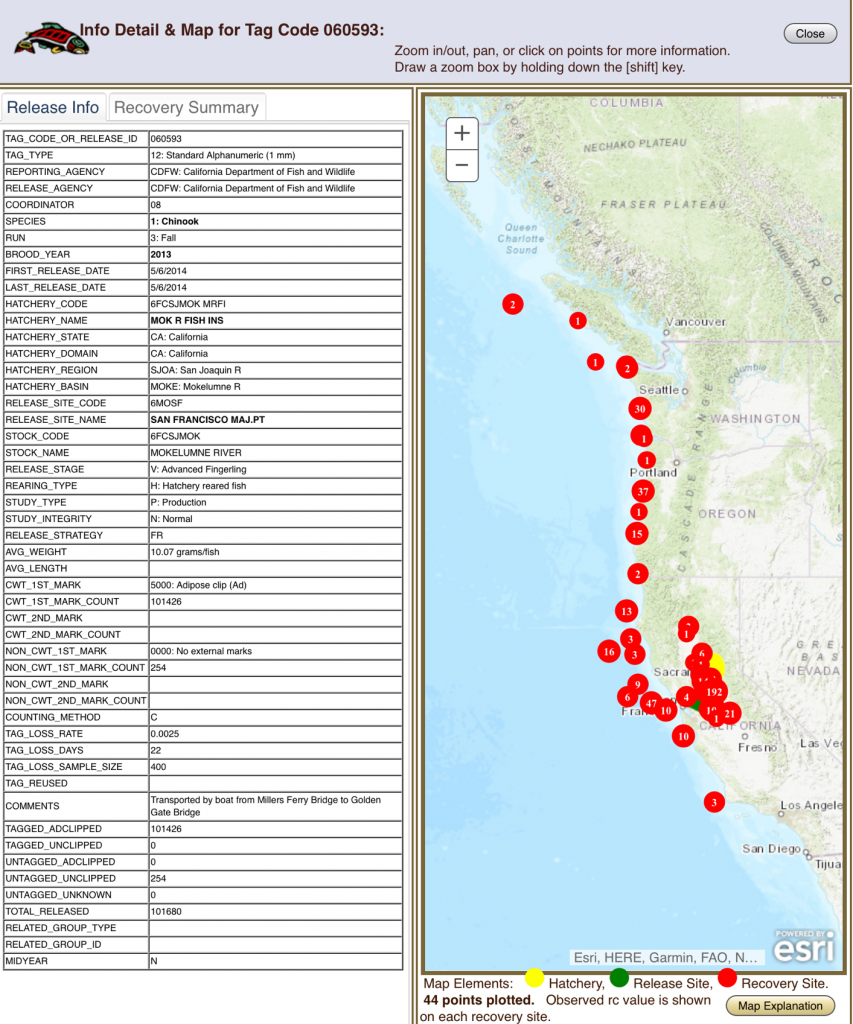The number of fall-run salmon released from the Feather River Fish Hatchery that are either captured in fisheries or that return to the Feather River as adults (% survival) varies from year to year and within each year.1 Recent patterns of survival to adulthood from brood years 2011-2013 provide insights into the effectiveness and potential success of different strategies for releasing smolts from the hatchery.
Brood Year 2011
DFW released nearly 7 million 2011 brood year smolts in spring 2012. Survival improved as fish were released with later in the season, with highest survival for late-released older smolts on the coast at Half Moon Bay (Figure 1). The declining late spring survival for the San Pablo Bay releases may be related to low late spring Delta Outflow in this below-normal water year (Figure 2). The late-season Half Moon Bay release group had a 5% rate of survival (Table 1), as compared to about 2% for late season releases from San Pablo Bay (North-East San Francisco Bay). Approximately three-quarters of survival to adulthood was accounted for in reports of fish captured, with the remainder from counts at spawning grounds and hatcheries.
Brood Year 2012
From the approximately 6.5 million Feather hatchery smolts of brood year 2012 released in spring of drought year 2013, Golden Gate releases had the highest survival rates at near 4% (Figure 3). Lower Sacramento River releases had poor success, with a survival rate to adulthood of less than 0.1%. This poor outcome is likely a consequence of low flow and high water temperatures in the river (Figures 4 and 5). Bay releases had relatively good returns of approximately 1.4-2.3% under relatively good Delta outflow conditions.
Brood Year 2013
Among the approximately 6.5 million Feather hatchery smolts of brood year 2013 released in spring of critical drought year 2014, most groups survived poorly (<1%; Figure 7). The group released to Half Moon Bay on the coast was an exception at 3.3%. One group released in San Pablo Bay on April 29 had a modest survival rate of 1.3%; their release occurred during a period of slightly higher Delta outflow (8000-9000 cfs; Figure 8). Other groups released to Bay or Delta had low survival; their release occurred under very low Delta outflow (3000-5000 cfs).
Straying
The most commonly stated concern for trucking and barging smolts to the Delta, Bay, Golden Gate, and coastal bays is straying of adult spawners to other rivers and hatcheries.
- The highest performing groups, HMBay releases, had the highest risk of straying being trucked to the coast outside the Golden Gate. Of the BY 2011 group’s (Table 1, Figure 1) hatchery returns, 534 (90%) were to its origin hatchery on the Feather River. This compares with the 91% return for corresponding release to San Pablo Bay net pens. This compares to 96% for the FR group.
- Golden Gate releases had similar straying rates. For BY 2012 (Figure 3), trucked smolts had 92% of hatchery returns to the origin hatchery, while barged fish had 93% return. These rates compare to 81% of hatchery returns to origin hatchery for the 5/23 SPB net pen group. Only two fish returned to Central Valley hatcheries (both to Feather River Hatchery) from the BY 2012 FRiv group.
Summary
- The rate of survival to adulthood of hatchery release groups was higher in wetter years.
- Early spring (prior to mid April) smolt releases had lower survival rates than later spring releases.
- Survival of smolts released in-river was modest in wetter years and very poor in dry years.
- Highest rates of survival (4-5%) were from Half Moon Bay on the coast south of San Francisco.
- San Pablo Bay pen release return rates were better (2-3%) under higher Delta outflow; returns were poorer (<1%) when San Pablo releases occurred during periods of low Delta outflow (3000-5000 cfs).
- Straying rates overall were generally low (5-10%). The lowest straying rate (4%) was from river release at mouth of Feather River.
Conclusions
Coastal and Golden Gate smolt releases provide the highest rates of survival to adulthood. Stray rates for these release groups are low. Rates of survival for smolts released in-river and in San Pablo Bay are poor in drier years with low Delta outflow.
The best strategy for high rates of survival would appear to be to make most or all releases in drier years at the coast and the Golden Gate, and to make releases in wetter years in-river and in San Pablo Bay. Releases of smolts to the rivers in dry years and in years with poor Delta outflow should be avoided, especially during late spring when flows are low and water temperatures are high.


Figure 1. Survival rates for brood year 2011 Feather River Hatchery smolts released in spring 2012. GG is Golden Gate. SPB is San Pablo Bay. FR is Feather River. HMBay is Half Moon Bay along the coast south of San Francisco.

Figure 2. Delta outflow in spring 2012.

Figure 3. Survival rates for brood year 2012 Feather River Hatchery smolts released in spring 2013. GG is Golden Gate. SPBNP is San Pablo Bay net pen. FRiv is Sacramento River below mouth of Feather River. HMBay is Half Moon Bay. SCruz is Santa Cruz harbor.

Figure 4. Sacramento River flow below mouth of the Feather River in spring 2013, along with historical average. Note lower than average flow in April and early May.

Figure 5. Sacramento River water temperatures below mouth of the Feather River in spring 2013, along with historical average. Note that water temperatures in spring 2013 were about 5oC above the long-term average through early June.

Figure 6. Delta outflow in spring 2013.

Figure 7. Survival rates for brood year 2013 Feather River Hatchery smolts released in spring 2014. GG is Golden Gate. SPBNP is San Pablo Bay net pen. Rio Vista is North Delta. HMBay is Half Moon Bay.

Figure 8. Delta outflow in spring 2014.








